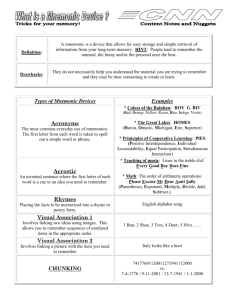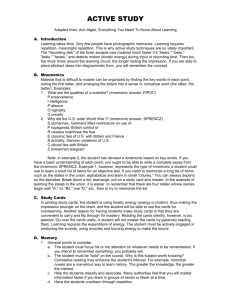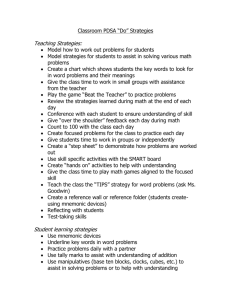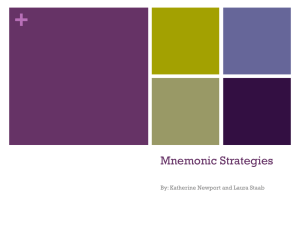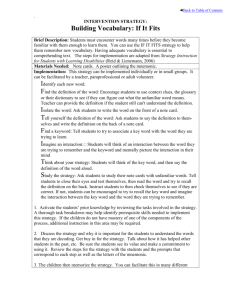Memory: The Computer Analogy
advertisement
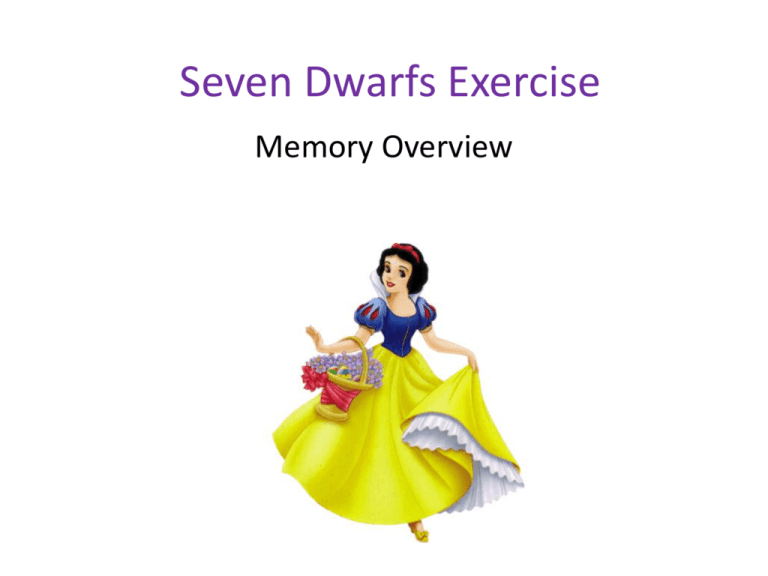
Seven Dwarfs Exercise Memory Overview How well did you do? What made the task difficult for some? • Connections: Memory is the persistence of learning over time… 1. Difficulty of Task • Culturally Bound • Story vs. Inconsequential Information • Too long since information was introduced • Environmental Distractions What processes did you go through? • Information Processing: Encoding (Get it into the Brain), Storage (Retain), Retrieval (Get it back out) Information Processing • Memory research examines factors that influence those processes: • Tip of the Tongue Phenomenon: Failure of Retrieval: (Students describe a word that they almost got…parts of it…what it started with, etc.) • Organization of Memory by Sound, Letter, and Meaning: • -Wrong guesses (Lazy, Clumsy, Droopy, Grouchy) • -Runs…one item triggers a sequence Recall vs. Recognition • Recall vs. Recognition: • -How many people would do better with a list in front of you? • -Recall=2 stages (Creation of possible targets + identification of correct ones) • -Recognition= Only first stage Answers • Most to Least Likely Recalled: Sleepy, Grumpy, Dopey, Sneezy, Happy, Doc, Bashful • Names that end in same sound most recalled: RUN • Bashful…absence of meaning STM vs. LTM • Short vs. Long Term Memory: Turn Paper over and recall again…better? • STM (5-9 items) More with chunking • LTM (Limitless) Memory: The Computer Analogy Accuracy? Stages of Memory Keyboard Disk Monitor (Encoding) (Storage) (Retrieval) Sequential Process Differences Between Brains and Computers • Although the brain-computer metaphor has served cognitive psychology well, research in cognitive neuroscience has revealed many important differences between brains and computers. Appreciating these differences may be crucial to understanding the mechanisms of neural information processing, and ultimately for the creation of artificial intelligence. Difference #1 • Brains=Analog • Computers=Digital • Many processes in the brain are non-linear. Difference #2 • Content addressable memory- Your brain can make associations between concepts whereas a computer simply pulls a specific address. You have a “built-in Google”. Difference #3 • The brain is a massively parallel machine while a computer is serial and modular. Difference #4 • Processing speed varies in the brain, while it is fixed in a computer. Difference #5 • RAM (Working memory) and Short Term Memory have some major differences: - The capacity of short term memory can vary based on processing speed. - Short Term Memory information holds only small clues as to what is in Long Term Memory. Difference #6 • Processing and memory are performed by the same components of the brain…as we are retrieving information, we are slightly altering it. Difference #7 • The brain is a self-organizing system. It is constantly morphing as a result of its own processes. Difference #8 • Brains have bodies: Your brain will offload responsibility to parts of your body…why remember where objects in your environment are when you have a perfectly good pair of eyes? Difference #9 • The brain is much, much bigger than any current computer. - Accurate biological models of the brain 225 million billion interactions between neural cells, and that doesn't include the approximately 1 trillion glial cells which may or may not be important for neural information processing. Clive Wearing BBC Clip • http://www.youtube.com/watch?v=wDNDRDJ y-vo Mnemonic Devices • Use meaning, organization, and imagery to successfully encode information. History of the Mnemonic • Greek poet Simonides ~500 BC… • Olympic games recitation where the banquet hall gave way leaving the bodies of the guests mutilated and unrecognizable. • By remembering where most of the guests had been sitting, Simonides could identify the victims. Method of Loci • Visualize a familiar room and place the items that need to be memorized in different locations. • Used by Cicero and other famous orators. Other Mnemonics • http://www.mindtools.com/memory.html - Link/Story Method Number/Rhyme or Shape Alphabet Journey Roman Room Major System Using the Journey Method • You may, as a simple example, want to remember something mundane like this shopping list: Coffee, salad, vegetables, bread, kitchen paper, fish, chicken breasts, pork chops, soup, fruit, bath tub cleaner. • You could associate this list with a journey to a supermarket. Mnemonic Image #1 • Front Door: Spilled coffee grinds on the doormat. Mnemonic Image #2 • Rose bush in front garden: growing lettuce leaves and tomatoes around the roses Mnemonic #3 • Car: with potatoes, onions and cauliflower on the driver's seat And So On… • End of the road: an arch of French bread over the road • Past garage: with its sign wrapped in kitchen roll • Under railway bridge: from which haddock and cod are dangling by their tails • Traffic lights: chickens squawking and flapping on top of lights And So On… • Past church: in front of which a pig is doing karate, breaking boards • Under office block: with a soup slick underneath: my car tires send up jets of tomato soup as I drive through it • Past car park: with apples and oranges tumbling from the top level • Supermarket car park: a filthy bath tub is parked in the space next to my car! Flashbulb Memories Exercise • Write down in a sentence or two your three most vivid memories. Events • • • • • • • • Car Accident (85) Meeting Best Friend (82) Graduations (81) Prom/Dance (78) Early Romantic Experience (77)] Speaking in front of an Audience (72) First Date (57) Night of 2000 presidential election (52) Events • • • • • • • First flight (40) SAT (33) 16th Birthday (30) The last holiday dinner at home (23) First high school class (21) First time parents left you alone (19) Thirteenth birthday (12) Flashbulb Memories • • • • Novel + Biologically Significant Accompanying Strong Emotions “Now Store”=Permanent Memory Recall usually includes aspects that are unrelated to meaningfulness of event itself…where you were when Kennedy was shot.
